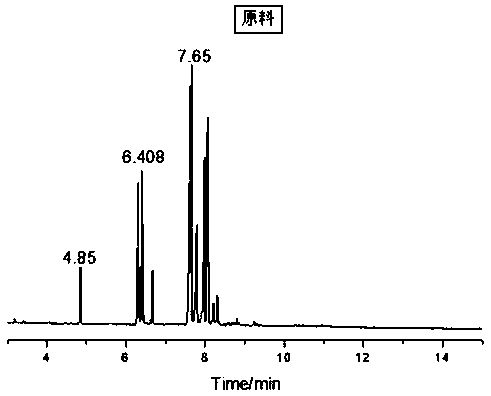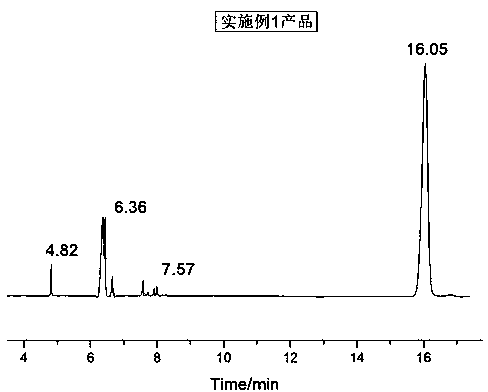Bacteriostatic diesel oil lubricity improver and preparation method thereof
An improver and lubricity technology, which is applied in the field of bacteriostatic diesel lubricity improver and its preparation, can solve the problems of bacteria breeding in diesel oil, wear of fuel injectors, engine failure, etc., so as to reduce internal binding effect and improve lubricity. , to avoid the effect of corrosion
- Summary
- Abstract
- Description
- Claims
- Application Information
AI Technical Summary
Problems solved by technology
Method used
Image
Examples
Embodiment 1
[0031] Preparation of tung oil methyl ester: Add 800g tung oil, 160g methanol, and 8g potassium hydroxide into a 2L high-pressure reactor, and carry out stirring reaction. The reaction temperature is 60°C, and the reaction time is 20min. Glycerin product 76.2g, then the upper layer product was washed 3 times with 50°C hot water, and the washed product was distilled at 2000Pa and 60°C for 2h to obtain tung oil methyl ester biodiesel.
[0032] Put 143g of 2-butenedialdehyde and 0.25g of hydroquinone into the reaction kettle, start stirring, and raise the temperature to 165°C for mixing. Gradually add 500 g of tung oil methyl ester biodiesel dropwise to the reaction kettle, so that the dropwise addition of tung oil methyl ester biodiesel is completed within 2 hours, and the rate of addition is basically uniform. Distillation under reduced pressure at ℃ for 2h to obtain the improver product. After calculation, the conversion rate of reaction molecules (conversion rate of carbon-c...
Embodiment 2
[0034] Put 72g of 2-butenedialdehyde and 0.15g of hydroquinone into the reaction kettle, start stirring, and raise the temperature to 150°C for mixing. Gradually add 500 g of tung oil methyl ester biodiesel dropwise to the reaction kettle, so that the addition of tung oil methyl ester biodiesel is completed within 2 hours, and the rate of addition is basically uniform. Distillation under reduced pressure at ℃ for 2h to obtain the improver product. The reaction molecular conversion rate was 84.95%, the acid value of the product was 1.4mgKOH / g, the freezing point was -26.9°C, and the water layer was not turbid in the demulsification test.
Embodiment 3
[0036] Put 432g of 2-butenedialdehyde and 0.5g of hydroquinone into the reaction kettle, start stirring, and raise the temperature to 180°C for mixing. Gradually add 500 g of tung oil methyl ester biodiesel dropwise to the reaction kettle, so that the addition of tung oil methyl ester biodiesel is completed within 2 hours, and the rate of addition is basically uniform. Distillation under reduced pressure at ℃ for 2h to obtain the improver product. The reaction molecular conversion rate is 86.07%, the acid value of the product is 1.2mgKOH / g, the freezing point is -27.5°C, and the water layer is not turbid in the demulsification test.
PUM
| Property | Measurement | Unit |
|---|---|---|
| Acid value | aaaaa | aaaaa |
| Solidifying point | aaaaa | aaaaa |
| Acid value | aaaaa | aaaaa |
Abstract
Description
Claims
Application Information
 Login to View More
Login to View More - R&D
- Intellectual Property
- Life Sciences
- Materials
- Tech Scout
- Unparalleled Data Quality
- Higher Quality Content
- 60% Fewer Hallucinations
Browse by: Latest US Patents, China's latest patents, Technical Efficacy Thesaurus, Application Domain, Technology Topic, Popular Technical Reports.
© 2025 PatSnap. All rights reserved.Legal|Privacy policy|Modern Slavery Act Transparency Statement|Sitemap|About US| Contact US: help@patsnap.com



